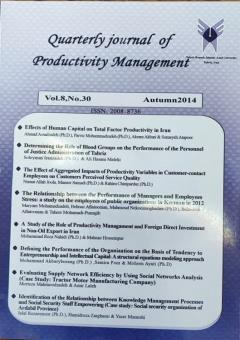بررسی رابطۀ بین عملکرد مدیران و فشارهای عصبی در بین کارمندان سازمانهای دولتی شهر کرمان در سال 1391
الموضوعات : Business Managementمریم محمدزاده 1 , بهناز افلاطونیان 2 , محمود نکویی مقدم 3 , بهنوش افلاطونیان 4 , طاهره محمدی پورنجیب 5
1 - کارشناس ارشد مدریت دولتی، پژوهشگر پایگاه تحقیقات بیمارستان شهید باهنر کرمان، ایران
2 - دانشجوی کارشناسی ارشد جامعه شناسی، پژوهشگر مرکز تحقیقات بیماریهای عفونی و گرمسیری، کمیته تحقیقات HSR و زئونوزها دانشگاه علوم پزشکی کرمان، ایران
3 - دانشیار، مرکزتحقیقات مدیریت ارائه خدمات سلامت،پژوهشکده آینده پژوهی در سلامت،دانشگاه علوم پزشکی کرمان، کرمان، ایران
4 - کارشناس مهندسی مدیریت پروژه، پژوهشگر کمیته تحقیقات HSR، دانشگاه علوم پزشکی کرمان، ایران.
5 - دانشجوی کارشناسی ارشدمدیریت منابع انسانی،گروه مدیریت،دانشکده ادبیات و علوم انسانی،دانشگاه آزاداسلامی واحدکرمان، ایران
الکلمات المفتاحية: عملکرد مدیران, سازمانهای دولتی, فشارهای عصبی,
ملخص المقالة :
فشارهای عصبی سازمانی علاوه بر تهدیدی برای سلامت کارمندان تاثیر نامطلوبی در بازده کاری و کمیت وکیفیت ارائه خدمات دارد. هدف از این تحقیق تعیین رابطۀ بین عملکرد مدیران و فشارهای عصبی در بین کارمندان سازمانهای دولتی می باشد. این پژوهش از نوع توصیفی- همبستگی است که در ان از نمونه گیری طبقه بندی تصادفی استفاده شد و تعداد سیصد پرسشنامه به نسبت نمونه در هر سازمان توزیع گردید. برای آنالیز اطلاعات از آزمون های همبستگی اسپیرمن، مدل لگ خطی و آزمون کای دو استفاده و تحلیل ها با نرم افزار spss18 انجام شد. نتایج نشان داد به طور معنا داری بین فشار عصبی و عملکرد مدیران رابطه وجود دارد که در بین زنان، متأهلین، کارمندان مسن تر، کارمندان با تحصیلات لیسانس و بالاتر و کارمندان با سابقۀ کار کمتر از بیست سال فشار های عصبی به طور معنا داری بیشتر است. با توجه به اهمیت نیروی انسانی در پیشرفت هر جامعه و جهت رسیدن به اهداف نظام سلامت و توسعه پایدار کشور، سیاستگذاران و مدیران ارشد منابع انسانی می توانند استراتژیهای مؤثری برای افزایش قابلیت و توانایی مدیران و بهره وری بیشتر از منابع ، طراحی و اجرا کنند.


